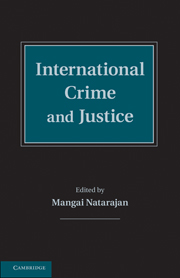Book contents
- Frontmatter
- Contents
- List of Figures
- List of Tables
- List of Contributors
- Foreword
- Preface
- Introduction
- Part I International Criminology
- 1 The Globalization of Crime
- 2 Routine Activities and Transnational Crime
- 3 Migration and Crime
- 4 Political Violence
- 5 Victimology
- 6 Children and International Criminal Justice
- 7 Women and International Criminal Justice
- 8 Culture and Crime
- Part II Law, Punishment, and Crime Control Philosophies of the World
- Part III Transnational Crime
- Part IV Organized Crime and Terrorism
- Part V International crime
- Part VI Delivering International Justice
- Part VII International Cooperation and Criminal Justice
- Part VIII International Research and Crime Statistics
- Part IX International research resources
- World Map
- Index
- References
8 - Culture and Crime
Published online by Cambridge University Press: 05 October 2014
- Frontmatter
- Contents
- List of Figures
- List of Tables
- List of Contributors
- Foreword
- Preface
- Introduction
- Part I International Criminology
- 1 The Globalization of Crime
- 2 Routine Activities and Transnational Crime
- 3 Migration and Crime
- 4 Political Violence
- 5 Victimology
- 6 Children and International Criminal Justice
- 7 Women and International Criminal Justice
- 8 Culture and Crime
- Part II Law, Punishment, and Crime Control Philosophies of the World
- Part III Transnational Crime
- Part IV Organized Crime and Terrorism
- Part V International crime
- Part VI Delivering International Justice
- Part VII International Cooperation and Criminal Justice
- Part VIII International Research and Crime Statistics
- Part IX International research resources
- World Map
- Index
- References
Summary
CULTURE, NORMS, AND TRANSGRESSIONS
This chapter explores the complex relationship between culture and crime. Social scientists define culture as a system of learned, shared ideas and behaviors. All cultural systems include basic ideas of what constitutes proper or improper actions. But not all actions interpreted to be incorrect or immoral by members of one culture may be thought of as such by another group. It is, therefore, important from the perspective of a global criminology to consider how the concept of crime is culturally constructed, that is, how ideas about what is right or wrong vary crossculturally. Describing such variation through ethnographic field research is one of the primary tasks of cultural anthropologists. Understanding how these variations are integrated with broader systems of power, subsistence, and economy is also a major goal for anthropologists.
Anthropologists broadly conceptualize the variety of acceptable and unacceptable behaviors across human societies as norms and transgressions. A norm is essentially what people expect other people to do. Most norms are informal and implicit expectations, which are so widely and consistently followed that there is no need for formal enforcement. For example, words or acts of politeness, such as saying “thank you” or shaking hands, comprise a set of exemplary customs of communication that most everyone performs. Other customs are usually repetitive behaviors, the rules of which are generally passed on orally between generations. For example, the Ju/’hoansi custom of bride service, whereby newly married males in this foraging society in the Kalahari Desert hunt for their bride’s parents, is common but not formally codified (Lee, 1993). Many norms, however, are formal, written rules expressed explicitly as laws. In state-level societies, these explicit codes (including statutes, regulations, and local ordinances) are considered to be mandatory and are enforced by representatives of the state.
- Type
- Chapter
- Information
- International Crime and Justice , pp. 57 - 64Publisher: Cambridge University PressPrint publication year: 2010

